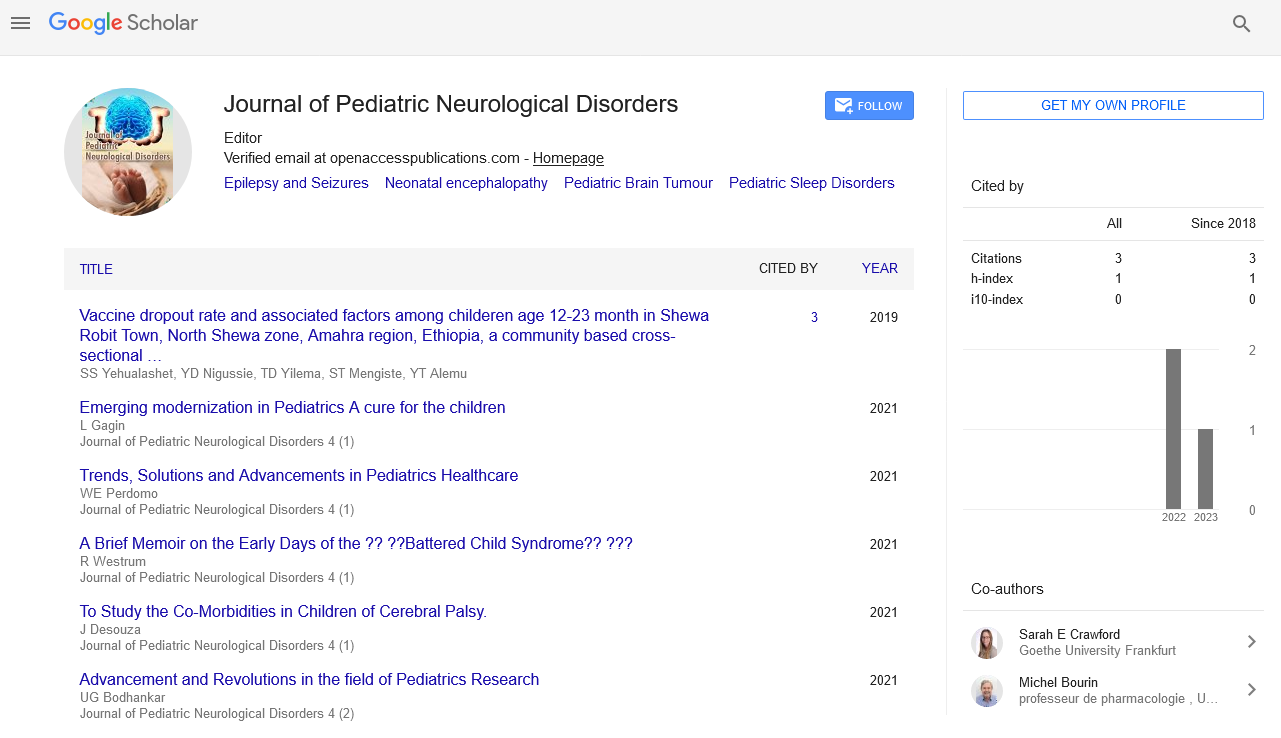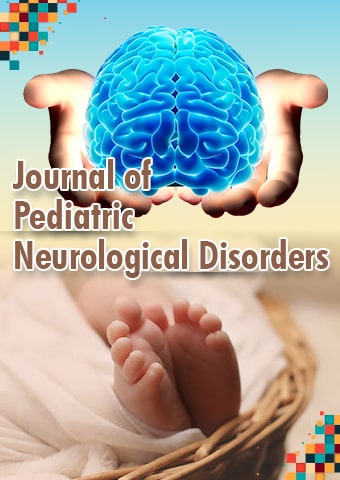Mini Review - Journal of Pediatric Neurological Disorders (2023) Volume 6, Issue 3
Maturation and Migration of Young brain
Eila Korhonen*
Department of Neurophysiology, University of Helsinki, Finland
Department of Neurophysiology, University of Helsinki, Finland
E-mail: korhoneneila@uh.ac.fn
Received: 01-June-2023, Manuscript No. pnn-23-103361; Editor assigned: 05-June-2023, PreQC No. pnn-23- 103361(PQ); Reviewed: 19- June- 2023, QC No. pnn-23-103361; Revised: 21-Apr-2023, Manuscript No. pnn-23-103361; Published: 28-June-2023, DOI: 10.37532/ pnn.2023.6(3).51-52
Abstract
Neuronal migration disorders and other neurodevelopmental disorders are best understood in relation to altered normal development. A wide range of molecular and cellular signaling serves as a guide for neuronal migration from their origin to their (usually cortical) destination. Neurons with abnormal migration include: 1) do not migrate and stay where they came from; 2) migrate in part but stay within the white matter; 3) migrate to the cortex without properly organizing; or (4) migrate excessively beyond the cortex. We discuss normal brain development and the malformations caused by these various migration abnormalities in this review.
Keywords
Neuronal migration disorder • Cortex • Brain development • Cellular signalling• Molecular signalling
Introduction
Because most abnormalities are best understood in the context of abnormal brain development, understanding abnormal brain development and normal brain development go hand in hand. We focused on the stages of development that can be examined with imaging and talked about normal brain development from early embryogenesis to postnatal life [1].
Migration disorder
When this is known or measurable, neurodevelopmental disorders are typically best described by the disrupted stage of brain development. A subset of neurodevelopmental disorders, migration disorders are caused by abnormal neuronal migration. Neurons could:
1. Not migrate and remain where they were born (near the lateral ventricles);
2. Completely migrate within the white matter and remain there;
3. Migrate to the cortex but are unable to properly organize; or
4. Migrate excessively beyond the cortex.
The underlying etiology (germline genetic, somatic mutation, or injury/insult) and the affected gene or pathway determines whether the migration abnormality is focal, regional, or diffuses. Migrational disorder patients with somatic mutations can be CNS mosaics for that mutation, which means that the mutation only affects a small portion of the central nervous system. As a result, patients with the same mutation can have different phenotypes. In the section that follows, we go over the disorders that occur at various stages of disrupted migration, as well as their clinical manifestations [2, 3].
Cortical dysplasia
When neurons successfully migrate along the radial glial cells in the developing cortex, they typically detach from their glial support in the appropriate cortical layer and are separated from the subarachnoid space by the pial limiting membrane. A cobblestone cortex is a thickened and disorganized cortex that results from neurons migrating beyond the cortex through these gaps and into the subarachnoid space when the pial limiting membrane fails to form or is disrupted. On imaging and gross pathologic examination, the macroscopic morphology varies depending on the size of the gaps in the pial limiting membrane, despite the common cellular cause. Multiple tiny gyri appear as small gaps in the glia limitans, while a thickened cortex appears as a larger gap. Cobblestone malformations or a cobblestone cortex are the collective names given to these appearance shifts as the brain develops, sulcates, and myelinates. The X-ray appearance (polymicrogyria refrains pachygyria) is of no outcome as far as etiology or result, and accentuation on this descriptor, or utilization of the imaging aggregate as a determination, is something best stayed away from. Cobblestone cortex is present in syndromic settings, particularly in tubulinopathies and congenital muscular dystrophies. Microcephalies and congenital muscular dystrophies are separate topics that were not further discussed in this article [4].
Commissural abnormalities
The advancement of the cerebral commissures can be changed or upset in various ways, prompting a wide assortment of unusual commissural aggregates. When it is an isolated malformation, the most visually apparent phenotype, complete agenesis of the Corpus Callosum (CC), frequently results in a clinical phenotype that is milder than cases of CC hypo genesis. We briefly mentioned in this discussion that damage to the cerebral hemispheres frequently causes commissural abnormalities. In case of cerebral injury,there are no resultant white matter parcels from the area of injury that need to cross the midline. Midline lipomas or cysts are associated with commissural abnormalities; these structures can be quite large, and they have a mass effect on the structures next to them. Numerous syndromes are associated with callosal abnormalities, and in the case of syndromic commissural abnormalities, the clinical characteristics of the syndrome define the clinical phenotype far more completely than the morphology of the commissural abnormality. These instances of secondary CC hypogenesis are not further discussed because they have little to do with altered axonal migration or pathfinding [5, 6].
Hypogenesis of the corpus callosum
The most common cause of hypogenesis of the corpus callosum is either another inciting cortical malformation or a developmental injury to the cerebral hemispheres. Patients with isolated CC hypogenesis may paradoxically exhibit clinical phenotypes that are more severe than those with complete agenesis [7, 8]. The glial sling does not develop in areas where the midline does not differentiate in disorders like lobar or middle interhemispheric variant holoprosencephaly, and as a result, the CC does not form in those regions. Neither Probst bundles nor abnormal ventricular morphology are linked to CC hypogenesis [9, 10].
Conclusion
In addition to providing insight into brain function, understanding normal brain development is essential for the interpretation of normal imaging findings. Additionally, neurodevelopmental disorders are frequently best understood in relation to the disrupted developmental processes. We emphasized the crucial stage of in utero cortical development, specifically the migration of neurons from the germinal zones to the developing cortex along radial glial cells, in this review of disorders of neuronal migration. The majority of migration disorders are caused by disturbances in this crucial process, which results in either neuronal under-migration (or the heterotopia that follows in the grey matter) or over-migration (and disorders like cobblestone cortex).
References
- Meijer IA, Pearson TS. The twists of pediatric dystonia: Phenomenology, classification, and genetics. Semin Pediatr Neurol. 25, 65-74 (2018).
- Zorzi G, Zibordi F, Garavaglia B. Early onset primary dystonia. Eur J Paediatr Neurol. 13, 488-492 (2009).
- Segawa M. Autosomal dominant GTP cyclohydrolase I (AD GCH 1) deficiency (Segawa disease, dystonia 5; DYT 5). Chang Gung Med J. 32, 1-11 (2009).
- Balint B, Bhatia KP. Isolated and combined dystonia syndromes - an update on new genes and their phenotypes. Eur J Neurol. 22, 610-617 (2015).
- Kurian MA, Gissen P, Smith M. The monoamine neurotransmitter disorders: an expanding range of neurological syndromes. Lancet Neurol. 10, 721-733 (2011).
- Hayflick SJ, Kurian MA, Hogarth P. Neurodegeneration with brain iron accumulation. Handb Clin Neurol. 147, 293-305 (2018).
- Roberts EA, Socha P. Wilson disease in children. Handb Clin Neurol. 142, 141-156 (2017).
- Goraya JS. Acute movement disorders in children: experience from a developing country. J Child Neurol. 30, 406-411 (2015).
- Waln O, Jankovic J. Paroxysmal movement disorders. Neurol Clin. 33, 137-152 (2015).
- Koch H, Weber YG. The glucose transporter type 1 (Glut1) syndromes. Epilepsy Behav. 91, 90-93 (2019).
Indexed at, Crossref, Google Scholar
Indexed at, Crossref, Google Scholar
Indexed at, Crossref, Google Scholar
Indexed at, Crossref, Google Scholar
Indexed at, Crossref, Google Scholar
Indexed at, Crossref, Google Scholar
Indexed at, Crossref, Google Scholar
Indexed at, Crossref, Google Scholar

